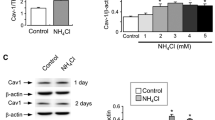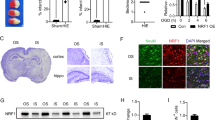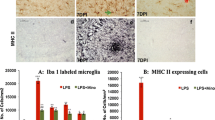Abstract
Glutamate is the major excitatory neurotransmitter in the central nervous system, and evidence for peripheral glutamatergic fibers in mammals is still lacking. However, glutamate receptors have been identified in peripheral organs, including taste buds, myenteric plexus, and pancreatic islet cell. Protection against anoxic damage could also be explained by mechanisms mediated by postsynaptic mGluR2 or mGluR3, such as the inhibition of membrane excitability resulting from a reduction of cAMP formation by a G-protein-dependent modulation of ion channels. In addition, activation of mGluR3 present in glial cells may contribute to neuroprotection by enhancing the production of death. Thus, mGluR2/3 behaves potentially as a major defensive mechanism anoxia-tolerant species. There are a few reports for the regional pattern of hypoxic damage, which was inversely related to the expression of mGluR2/3. The aim of this study was to characterize the expression of mGluR3 in hypoxic liver in experimental model of rat liver. Proteomic analysis of protein extracts from CCl4–induced cirrhotic liver revealed the presence␣of the mGluR3. The presence of mGluR3 in the cirrhotic liver was confirmed by immunohistochemical analysis. There were a number of macrophages expressing mGluR3 mainly in the fibrous septa. After 2 weeks recovery, however, most of mGluR3 positive macrophages disappeared with collagen fibers. These results demonstrate that mGluR3 involved in the liver in response to persistent hypoxic status such as fibrotic/cirrhotic condition, and suggest that the expression of mGluR3 may be a key role functional metabolism and viability in the liver by interacting with the glutamate receptors in vivo.
Similar content being viewed by others
References
Pin JP, Duvoisin R (1995) The metabotropic glutamate receptors: structure and functions. Neuropharmacology 34:1–26
Steinhauser C, Gallo V (1996) News on glutamate receptors in glial cells. Trends Neurosci 19:339–345
Schoepp DD, Jane DE, Monn JA (1999) Pharmacological agents actins at subtypes of metabotropic glutamate receptors. Nerupharmacology 38:1431–1476
Mao JR (2002) Translational pain research: bridging the gap between basic and clinical research. Pain 97:183–187
Werner P, Pitt D, Raine CS (2001) Multiple sclerosis: altered glutamate homeostasis in lesions correlates with oligodendrocyte and axonal damage. Ann Neurol 50:169–180
Storto M, de Grazia U, Knopfel T, Canonico PL, Copani A, Richelmi P, Nicoletti F, Vairetti M. (2000) Selective blockade of mGlu5 metabotropic glutamate receptors protects rat hepatocytes against hypoxic damage. Hepatology 31:649–655
Storto M, Battaglia G, Gradini R, Bruno V, Nicoletti F, Vairetti M (2004) Mouse hepatocytes lacking mGlu5 metabotropic glutamate receptors are less sensitive to hypoxic damage. Eur J Pharmacol 497:25–27
Kobayashi N, Ito M, Nakamura J, Cai J, Gao C, Hammel JM, Fox IJ (2000) Hepatocyte transplantation in rats with decompensated cirrhosis. Hepatology 31:851–857
Smith PK, Krohn RI, Hermanson GT, Mallia AK, Gartner FH, Provenzano MD, Fujimoto EK, Goeke NM, Olson BJ, Klenk DC (1985) Measurement of protein using bicinchoninic acid. Anal Biochem 150:76–85
Fountoulakis M, Suter L (2002) Proteomic analysis of the rat liver. J Chromatogr B Anal Technol Biomed Life Sci 782:197–218
Low TY, Seow TK, Chung MCM (2002) Separation of human erythrocyte membrane associated proteins with one-dimensional and two-dimensional gel electrophoresis followed by identification with matrix-assisted laser desorption/ionization-time of flight mass spectrometry. Proteomics 2:1229–1239
Matsui T, Takano M, Miyamoto K, Itoh Y, Yoshizawa H, Koike M, Mochizuki T, Tanaka E, Okamoto H, Imai M, Mishiro S, Miyakawa Y, Mayumi M (1986) Nude mice bearing human primary hepatocellular carcinoma that produces hepatitis B surface, core, and e antigens, as well as deoxyribonucleic acid polymerase. Gastroenterology 90:135–142
Harrington MC, Henehan GT, Tipton KF (1987) The roles of human aldehyde dehydrogenase isoenzymes in ethanol metabolism. Prog Clin Biol Res 232:111–125
Jakoby WB, Ziegler DM (1990) The enzymes of detoxication. J Biol Chem 265:20715–20718
Lindahl R (1992) Aldehyde dehydrogenases and their role in carcinogenesis. Crit Rev Biochem Mol Biol 27:283–335
Gething MJ, Sambrook J (1992) Protein folding in the cell. Nature 355:33–45
Patton AJ, Genever PG, Birch MA, Suva LJ, Skerry TM (1998) Expression of an N-methyl-d-aspartate-type receptor by human and rat osteoblasts suggests a novel glutamate signaling pathway in bone. Bone 22:645–649
Genever PG, Maxfield SJ, Kennovin GD, Maltman J, Bowgen CJ, Raxworthy MJ, Skerry TM (1999) Evidence for a novel glutamate-mediated signaling pathway in keratinocytes. J Invest Dermatol 112:337–342
Brice NL, Varadi A, Ashcroft SJ, Molnar E (2002) Metabotropic glutamate and GABA(B) receptors contribute to the modulation of glucose-stimulated insulin secretion in pancreatic β cells. Diabetologia 45:242–252
Shannon HE, Sawyer BD (1989) Glutamate receptors of the N-methyl-d-asparate subtype in the myenteric plexus of the guinea pig ileum. J Pharmacol Exp Ther 251:518–523
Sinsky M, Donnerer J (1998) Evidence for a neurotransmitter role of glutamate in guinea pig myenteric plexus neurons. Neurosci Lett 258:109–112
Gill SS, Pulido OM, Muller RW, McGuire PF (1999) Immunochemical localization of the metabotropic glutamate receptors in the rat heart. Brain Res Bull 48:143–146
Rzeski W, Turski L, Ikonomidou C (2001) Glutamate antagonists limit tumor growth. Proc Natl Acad Sci USA 98:6372–6377
Storto M, Ngomba RT, Battaglia G, Freitas I, Griffini P, Richelmi P, Nicoletti F, Vairetti M (2003) Selective blockade of mGlu5 metabotropic glutamate receptors is protective against acetaminophen hepatotoxicity in mice. J Hepatol 38:179–187
Ferguson SS (2001) Evolving concepts in G protein-coupled receptor endocytosis: the role in receptor desensitization and signaling. Pharmacol Rev 53:1–24
Dale LB, Babwah AV, Ferguson SS (2002) Mechanisms of metabotropic glutamate receptor desensitization: role in the patterning of effector enzyme activation. Neurochem Int 41:319–326
Mundell SJ, Pula G, Carswell K, Roberts PJ, Kelly E (2003) Agonist-induced internalization of metabotropic glutamate receptor 1A: structural determinats for protein kinase C- and G protein-coupled receptor kinase-mediated internalization. J Neurochem 84:294–304
Yang D, Gereau RW IV (2002) Peripheral group II metabotropic glutamate receptors (mGluR2/3) regulate prostaglandin E2-mediated sensitization of capsaicin responses and thermal nociception. J Neurosci 22:6388–6393
Boxall SJ, Berthele A, Laurie DJ, Sommer B, Zieglgansberger W, Urban L, Tolle TR (1998) Enhanced expression of metabotropic glutamate receptor 3 messenger RNA in the rat spinal cord during ultraviolet irradiation induced peripheral inflammation. Neuroscience 82:591–602
Jeong WI, Lee CS, Park SJ, Chung JY, Jeong KS (2002) Kinetics of macrophages, myofibroblasts and mast cells in carbon tetrachloride-induced rat liver cirrhosis. Anticancer Res 22:869–877
Rothman JE (1989) Polypeptide chain binding proteins: catalysts of protein folding and related processes in cells. Cell 59:591–601
Dolan S, Nolan AM (2002) Behavioural evidence supporting a differential role for spinal group I and II metabotropic glutamate receptors in inflammatory hyperalgesia in sheep. Neuropharmacology 43:319–326
Acknowledgement
The work presented in this paper was supported by the Brain Korea 21 Project in 2006.
Author information
Authors and Affiliations
Corresponding author
Rights and permissions
About this article
Cite this article
Do, S.H., Yun, HS., Jeong, WI. et al. Up-regulation of Metabotropic glutamate receptor 3 (mGluR3) in rat fibrosis and cirrhosis model of persistent hypoxic condition. Mol Cell Biochem 294, 189–196 (2007). https://doi.org/10.1007/s11010-006-9259-7
Received:
Accepted:
Published:
Issue Date:
DOI: https://doi.org/10.1007/s11010-006-9259-7




